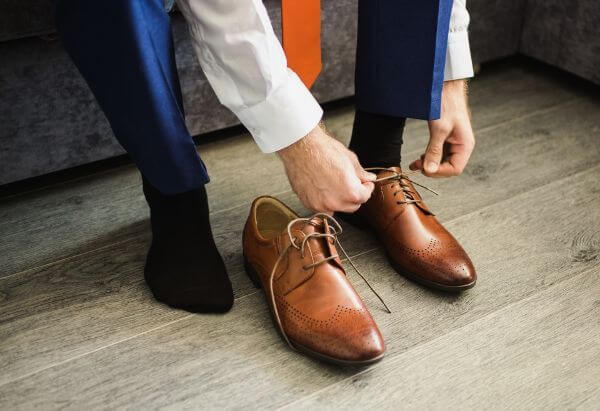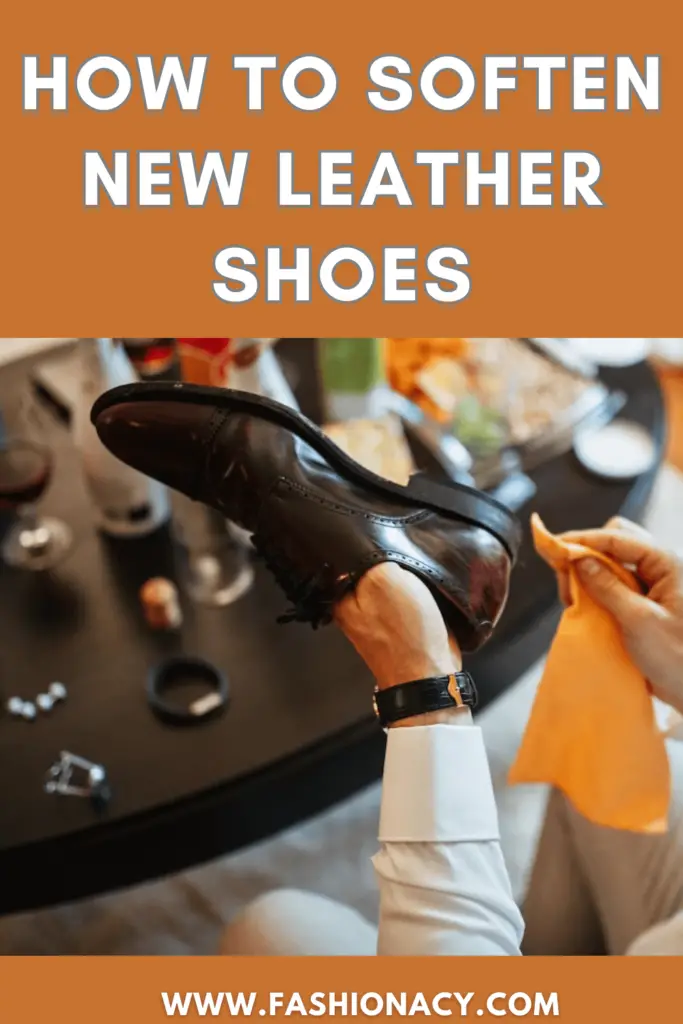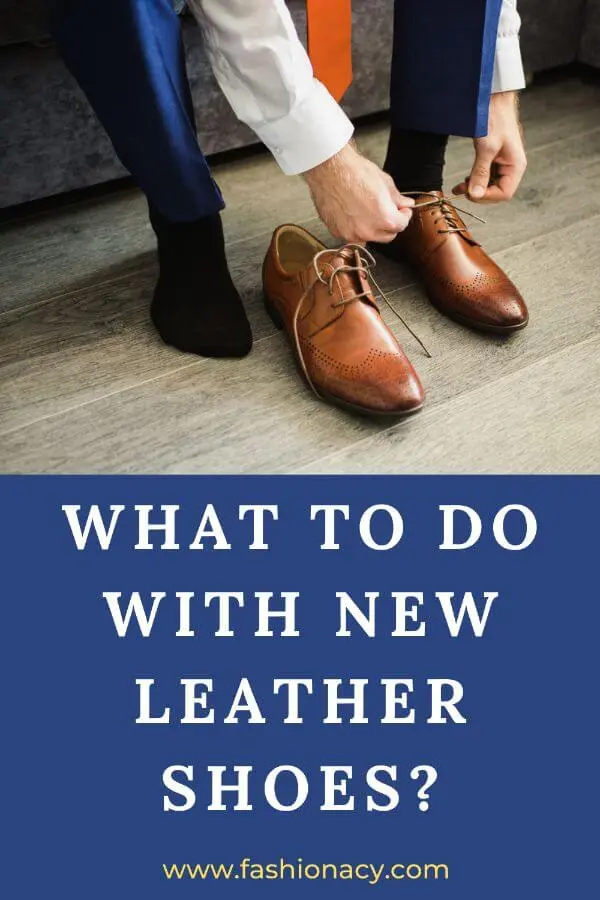
Congratulations! You’ve recently invested in a new pair of leather dress shoes. Are they, however, ready to be worn?
There’s a lot of poor advice out there about how to prepare your shoes for wear.
To avoid slipping, some people recommend using a knife to generate traction on the leather soles. That isn’t the only issue you have to deal with.
A water-resistant seal does not come standard on new leather shoes. They are vulnerable to harm from water and salt.
Not to mention the need of breaking in your shoes. If you don’t do this, you can end up with blisters all over your feet.
Wear Them at Home
The first tip is to wear your shoes on inside the house.
There’s no replacement for actually wearing the shoes to assess whether or not they’re a good fit.
The problem is that if you wear them outside and on concrete, the sole will be scratched. The majority of companies will not accept these shoes back.
So, one method to get around this is to wear your shoes inside on carpet so that you don’t damage the sole, but you can immediately assess how well they fit.
Congratulations if you found the ideal match. But what if the fit isn’t quite right?
If it’s just a tiny fit issue, such as they’re a little too tight or there’s a hotspot on the heel, you can actually remedy some of them using heat, which I’ll go through in a minute.
But, if it’s a severe issue, such as being a size too big, guess what? You are free to return them.
Protip. Did you know that different shoe brands utilize different lasts, also known as the foot mold, to size their shoes?
A size 9 from one brand will not fit the same as a size 9 from another company. Finding a company whose sizing works for you is what I would concentrate on.
Make Use Of Heat
The second tip is to use heat to loosen up any tightness or hotspots.
When it comes to new shoes, when you first put them on, they might be quite stiff. Leveraging the power of heat is one technique to get rid of stiffness.
Run a hairdryer over the shoes for a few minutes, concentrating on the hotspots. Warming up the leather and making it more supple is what you’re after.
When you put on your warm leather shoes, you should notice that they fit a little better, and as you wear them throughout the day, they will conform to your feet better.
Create Traction
The next step is to make your leather soles grippy.
You’re certain you want to keep the shoes at this stage. It’s now time to take care of those slick leather soles.
Why bother with leather soles in the first place? Why would you want them in the first place? Leather soles are a symbol of quality, gentlemen. And, historically, they’ve been seen on high-end menswear footwear.
The trouble with leather soles, as everyone who has ever fallen in them knows, is that they provide no traction when you step on water or ice.
Simply rough up the sole; you want to make a sole that can truly provide you with traction.
This isn’t something you want to do with a knife. No, cutting too deeply into the leather will ruin the sole.
Instead, go over the sole with 80-grit sandpaper to rough it up. What if you don’t have any sandpaper? So, let’s make this simple.
Go out to your sidewalk and drag your feet around to make little scratches and grooves that will provide traction.
Is it still too slick? Do you wish to gain greater traction? Simply go to your local big box store, perhaps a cobbler, or hunt for rubber shoe grips online.
These rubber shoe grips adhere to the bottom of your shoes with a tiny bit of glue, providing traction and preventing you from slipping and sliding all over the place.
Shoe Horn
The next step is to purchase a shoe horn.
Did you know that the majority of men put on their dress shoes incorrectly? They simply shove their foot in there, causing damage to the back of the shoe.
You should start using a shoe horn to keep it from bending and deforming over time.
When it comes to purchasing a shoe horn, there are numerous options available, including 6-inch plastic horns, 12-inch metal horns, and 24-inch horns made of horn.
Which option should you choose? It doesn’t matter; all you have to do is use a shoe horn to extend the life of your shoes.

Extra Shoe Laces
The next piece of advice is to stock up on extra shoelaces.
Shoelaces always seem to break right before that interview, right before you’re ready to walk on stage and give the most important presentation of your life.
Buy extra laces to be safe. When you buy new shoes, you want to make things as simple as possible for yourself in the future.
Because they’re all created by the same manufacturer, you simply have to replace the one that breaks. You don’t have to worry about matching them up.
Cedar Shoe Trees
The next item on the to-do list is to purchase cedar shoetrees.
The majority of individuals disregard this piece of advice. Regrettably, this results in the untimely demise of their shoes.
Your fresh new dress shoes may look lovely right now, but if you don’t look after them, they won’t last long.
Cedar shoetrees are fantastic since they keep the natural look of your dress shoes even when you aren’t wearing them.
When you wear dress shoes, you sweat in them and have to reshape them every time you bend them.
Shoetrees go in there and keep the shape while preventing creases from forming.
You should store your leather dress shoes with cedar shoetrees when you aren’t wearing them and within hours after taking them off.
They’ll keep the form, the appearance, and the value of your purchase.
Leather Conditioner
Apply leather conditioner to the leather. It’s a cream that penetrates the leather and helps to soften it. By the way, if you’re having trouble with your fit, this is fantastic.
There are some hotspots if the shoes are a little too snug, and guess what? To make the leather more pliable, apply a small amount of leather conditioner.
You should use leather conditioner at least once a season throughout the life of your shoes. Why?
If you reside in a dry area, such as the desert, your leather will dry out and become brittle. Unless you use a leather conditioner, it can get excessively dry and crack.
If you reside in a damp environment, water will often penetrate and then depart, and as it leaves, it will pull out a little extra, causing water damage.
Leather conditioner will prevent this from happening.
Wax Polish
After that, you’ll need to apply a wax polish. When you use wax polish on your shoes, you’re effectively killing two birds with one stone.
To begin with, it gives your shoes a gorgeous sheen, draws people’s attention, and results in a slew of praises.
Second, that thin coating of wax serves as a barrier. It’s the wax that gets scuffed and scraped when you get scuffs and scrapes. It will also act as a thin layer of water resistance.
When it comes to matching the wax color to your shoes, strive to go as near as you can. If you can’t find anything that works, a neutral wax will suffice.
A neutral wax will still add a little luster and, more crucially, protection.
Waterproof Spray
Apply a water proofing spray next. That wax layer does offer some protection. However, if you’re wearing light-colored shoes and running through slush and snow, you’ll need more protection.
You’ll need a silicone-based water proofing spray for this.
Before spraying it all over your shoes, especially if they’re light-colored, test it on the tongue to see if it darkens them.
After the test, you should go ahead and spray the entire shoe with light strokes. Allow the shoe to dry for a few hours before applying a second coat.
Your shoes now have a hydrophobic covering all over them to keep moisture out.



